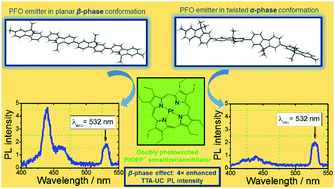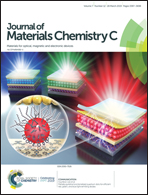Impact of molecular conformation on triplet-fusion induced photon energy up-conversion in the absence of exothermic triplet energy transfer†
Abstract
The use of photon energy up-converted luminescence driven by triplet-exciton annihilation reactions (TTA-UC) is increasingly gaining attention for developing next-generation light-management, and wavelength-shifting technologies. Here we present a spectroscopic study for elucidating the photophysical mechanism that operates in an unusual TTA-UC model system comprising the blue-light emitting poly(fluorene-2-octyl) (PFO) activator mixed with the green-light absorbing (2,3,7,8,12,13,17,18-octaethyl-porphyrinato) PtII (PtOEP) metalo-organic complex. The unconventional character of the PFO:PtOEP composite manifests in the fact that no exothermic triplet energy transfer (TET) is possible between triplet-excited PtOEP and PFO. Yet green-to-blue TTA-UC luminescence of PFO is obtained even when PtOEP is selectively photoexcited by pulsed laser intensities as low as 2.5 mW cm−2. Continuous-wave photo-induced absorption spectroscopy verifies that no energy transfer from triplet-excited PtOEP to the triplet level of PFO takes place, pointing to triplet–triplet annihilation (TTA) events in the PtOEP phase as the origin of the observed TTA-UC PL signal. In the PFO:PtOEP composite, the PtOEP component holds a dual role of annihilator/sensitizer; photon energy storage in PtOEP is enabled via TTA when triplet exciton diffusion coefficient values of DPtOEP = 4.1 × 10−9 cm2 s−1 are reached. With a simple yet powerful solution processing protocol, and by combining Raman and time-gate photoluminescence (PL) spectroscopy we demonstrate that the brightness of the produced TTA-UC luminescence depends on the molecular conformation of the PFO activator. A four-fold increase in the TTA-UC luminescence intensity is registered in the time-integrated and time-gated PL spectra, when the PFO matrix is arrested in its planar β-phase molecular conformation. Further enhancement of the TTA-UC PL signal is achieved when temperature lowers from 290 K down to 100 K. These results stimulate the development of a theoretical model for the microscopic description of triplet exciton migration in disordered photon up-converting solids. Efficient harvesting of photon energy, which is stored in annihilator/sensitizer moieties via TTA events, can be enabled when the molecular conformation of the activator species is properly tuned.

- This article is part of the themed collection: Editor’s Choice: Progress in singlet fission and photon upconversion


 Please wait while we load your content...
Please wait while we load your content...